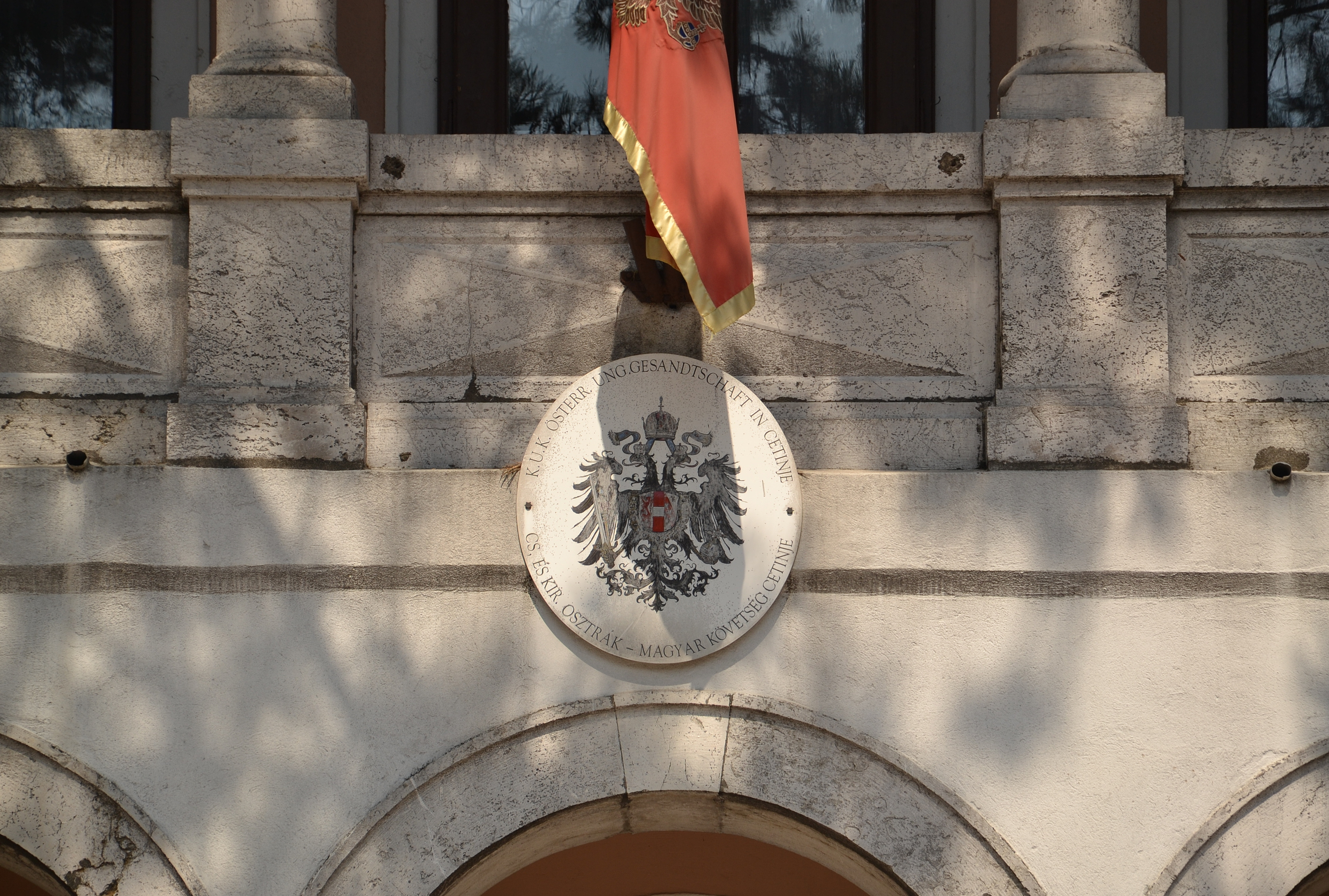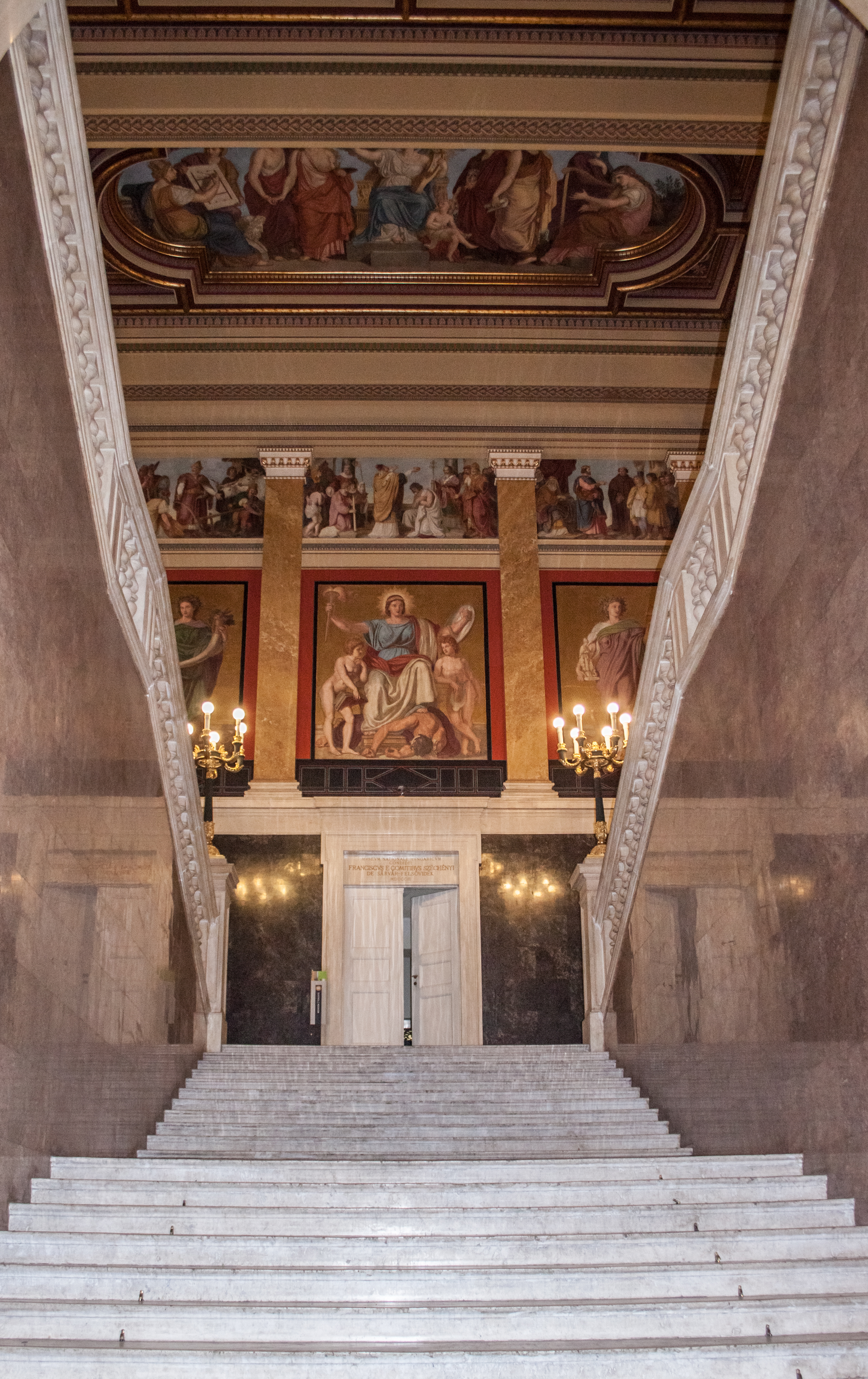|
Imre Széchényi
Count Emmerich "Imre" Széchényi of Sárvár-Felsővidék (15 February 1825 – 11 March 1898), was a Hungarian nobleman and landowner, and Austro-Hungarian diplomat and politician. He was Austrian ambassador in Berlin during the government of Bismarck. He signed for the Austrian emperor Bismarck's Alliance of the Three Emperors 1873, and represented Austria at the Berlin Conference on the Congo 1884. Early life Széchényi was born on 15 February 1825 in Vienna into a prominent Hungarian noble family. He was the son of Count Ludwig "Lajos" Maria Aloys Széchenyi (1781–1855) and, his second wife, Austrian Countess Francisca (née von Wurmbrand-Stuppach) Széchenyi (1797–1873). The Széchényi family were one of the oldest and wealthiest in the Austro-Hungarian Empire. His maternal grandparents were Count Heinrich von Wurmbrand-Stuppach and Baroness Josefa von Ledebur-Wicheln. His father was the eldest son of Countess Julia Festetics de Tolna and Count Ferenc Széchény ... [...More Info...] [...Related Items...] OR: [Wikipedia] [Google] [Baidu] |
Austro-Hungarian Ambassadors
This is a list of diplomatic missions of Austria-Hungary from the formation of the Austria-Hungary, Dual Monarchy in 1867 until it was dissolved in 1918. For a background to the diplomatic service of Austria-Hungary, including the types of diplomatic representation, see Austro-Hungarian Foreign Service. History Austria-Hungary had 110 non-honorary consulates and 364 honorary consulates, for a total of 474, in pre-war 1914. This number declined as a result of World War I; consulates in Italy and the U.S. respectively closed in 1915 and 1917, making up the majority of consulates closed in those years. The number of consulates declined to 307 upon the declaration of war in 1914. This declined to 273 in 1915, 227 in 1916, and 193 in 1917. In 1918, upon the end of the empire, Austria-Hungary had 13 consulates-general, 18 other consulates, a consular agency, and a vice-consulate.Agstner, Rudolf. ''Austria (-Hungary) and Its Consulates in the United States of America Since 1820''. LIT V ... [...More Info...] [...Related Items...] OR: [Wikipedia] [Google] [Baidu] |
Austrian Empire
The Austrian Empire, officially known as the Empire of Austria, was a Multinational state, multinational European Great Powers, great power from 1804 to 1867, created by proclamation out of the Habsburg monarchy, realms of the Habsburgs. During its existence, it was the third most populous monarchy in Europe after the Russian Empire and the United Kingdom of Great Britain and Ireland, United Kingdom, while geographically, it was the third-largest empire in Europe after the Russian Empire and the First French Empire. The empire was proclaimed by Francis II, Holy Roman Emperor, Francis II in 1804 in response to Napoleon's declaration of the First French Empire, unifying all Habsburg monarchy, Habsburg possessions under one central government. It remained part of the Holy Roman Empire until the latter's dissolution in 1806. It continued fighting against Napoleon throughout the Napoleonic Wars, except for a period between 1809 and 1813, when Austria was first allied with Napoleon ... [...More Info...] [...Related Items...] OR: [Wikipedia] [Google] [Baidu] |
Bratislava
Bratislava (German: ''Pressburg'', Hungarian: ''Pozsony'') is the Capital city, capital and largest city of the Slovakia, Slovak Republic and the fourth largest of all List of cities and towns on the river Danube, cities on the river Danube. Officially, the population of the city is about 475,000; however, some sources estimate daily number of people moving around the city based on mobile phone SIM cards is more than 570,000. Bratislava is in southwestern Slovakia at the foot of the Little Carpathians, occupying both banks of the Danube and the left bank of the Morava (river), River Morava. Bordering Austria and Hungary, it is the only national capital to border two sovereign states. The city's history has been influenced by people of many nations and religions, including Austrians, Bulgarians, Croats, Czechs, Germans, Hungarian people, Hungarians, Jews and Slovaks. It was the coronation site and legislative center and capital of the Kingdom of Hungary from 1536 to 1783; elev ... [...More Info...] [...Related Items...] OR: [Wikipedia] [Google] [Baidu] |
Imperial And Royal
The phrase Imperial and Royal (, ) refers to the court/government of the Habsburgs in a broader historical perspective. Some modern authors restrict its use to the Dual Monarchy of Austria-Hungary from 1867 to 1918. During that period, it indicated that the Habsburg monarch reigned simultaneously as the ( Emperor of Austria) and as the (King of Hungary), while the two territories were joined in a real union (akin to a two-state federation in this instance). The acts of the common government, which was responsible only for the Imperial & Royal ("I&R") Ministry of Foreign Affairs, the I&R Ministry of War and the I&R Ministry of Finance (financing only the two other ministries), were carried out in the name of "His Imperial and Royal Majesty", and the central governmental bodies had their names prefixed with Symbolic employment of or Before 1867, the territories under the control of the Habsburg monarch in Vienna used or the hyphenated interchangeably. Neither of the ... [...More Info...] [...Related Items...] OR: [Wikipedia] [Google] [Baidu] |
Minister Of Public Works And Transport (Hungary)
The minister of public works and transport of Hungary () was a member of the Hungarian cabinet from 1848 until 1889, when the ministry was merged into the Ministry of Trade. The last minister was Gábor Baross. Ministers of public works and transport (1848–1889) Kingdom of Hungary (1848–1849) Parties ''After the collapse of the Hungarian Revolution of 1848, the Kingdom of Hungary became an integral part of the Austrian Empire until 1867, when dual Austro-Hungarian Monarchy was created''. Kingdom of Hungary (1867–1889) Parties {, width=90% class="wikitable" style="text-align:center" , - ! # ! Picture ! Name ! From ! Until ! Political party ! Cabinet ! Assembly(Election) , - !rowspan="2" style="background-color:#AAD8E6; color:white" , 3 , rowspan="2", , rowspan="2", Imre Mikó(1805–1876) , rowspan="2", 20 February 1867 , rowspan="2", 21 April 1870 , rowspan="2", Deák Party , rowspan="4", Andrássy DP , 3 (1865) , - , rowspan="4", 4 (1869) , - !style="background ... [...More Info...] [...Related Items...] OR: [Wikipedia] [Google] [Baidu] |
The New York Times
''The New York Times'' (''NYT'') is an American daily newspaper based in New York City. ''The New York Times'' covers domestic, national, and international news, and publishes opinion pieces, investigative reports, and reviews. As one of the longest-running newspapers in the United States, the ''Times'' serves as one of the country's Newspaper of record, newspapers of record. , ''The New York Times'' had 9.13 million total and 8.83 million online subscribers, both by significant margins the List of newspapers in the United States, highest numbers for any newspaper in the United States; the total also included 296,330 print subscribers, making the ''Times'' the second-largest newspaper by print circulation in the United States, following ''The Wall Street Journal'', also based in New York City. ''The New York Times'' is published by the New York Times Company; since 1896, the company has been chaired by the Ochs-Sulzberger family, whose current chairman and the paper's publ ... [...More Info...] [...Related Items...] OR: [Wikipedia] [Google] [Baidu] |
Hungarian National Museum
The Hungarian National Museum (, ) was founded in 1802 and is the national museum for the history, art, and archaeology of Hungary, including areas not within Hungary's modern borders, such as Transylvania; it is separate to the collection of international art in the Hungarian National Gallery. The museum is in Budapest VIII in a Neoclassical building, purpose-built during 1837–47 by the architect Mihály Pollack. History The Hungarian National Museum traces its foundation to 1802, when Count Ferenc Széchényi set up the National Széchényi Library. This would then be followed a year later by the donating of a mineral collection by Széchényi's wife. This led to the creation of the Hungarian National Museum as a general history and natural history museum, beyond being simply a library. In 1807, the Hungarian National Parliament passed legislation on the new institution and asked the nation to help donate to the museum. The Hungarian Parliament of 1832–1834 helped ... [...More Info...] [...Related Items...] OR: [Wikipedia] [Google] [Baidu] |
National Széchényi Library
The National Széchényi Library (, ) (OSZK) is a library in Budapest, Hungary, located in Buda Castle. It is one of two Hungarian national libraries, the other being University of Debrecen Library. History The library was founded in 1802 by the highly patriotic Hungarian aristocrat Count Ferenc Széchényi. Széchényi traveled the world buying Hungarian books, which he assembled and donated to the nation. In 1803, the public library was opened in Pest. Széchényi's example resulted in a nationwide movement of book donations to the library. In 1808, the Hungarian National Assembly (" Diet") created the Hungarian National Museum to collect the historical, archaeological and natural relics of Hungary. The Museum was merged into the Library and for the last 200 years this is how it has existed, a national depository for written, printed and objective relics of the Hungarian past. In 1846, the Hungarian National Museum moved into its new building but it was not until 1949 tha ... [...More Info...] [...Related Items...] OR: [Wikipedia] [Google] [Baidu] |
Hungarian National Library
Hungarian may refer to: * Hungary, a country in Central Europe * Kingdom of Hungary, state of Hungary, existing between 1000 and 1946 * Hungarians/Magyars, ethnic groups in Hungary * Hungarian algorithm, a polynomial time algorithm for solving the assignment problem * Hungarian language, a Uralic language spoken in Hungary and all neighbouring countries * Hungarian notation, a naming convention in computer programming * Hungarian cuisine Hungarian or Magyar cuisine (Hungarian language, Hungarian: ''Magyar konyha'') is the cuisine characteristic of the nation of Hungary, and its primary ethnic group, the Hungarians, Magyars. Hungarian cuisine has been described as being the P ..., the cuisine of Hungary and the Hungarians See also * * {{disambiguation Language and nationality disambiguation pages ... [...More Info...] [...Related Items...] OR: [Wikipedia] [Google] [Baidu] |



